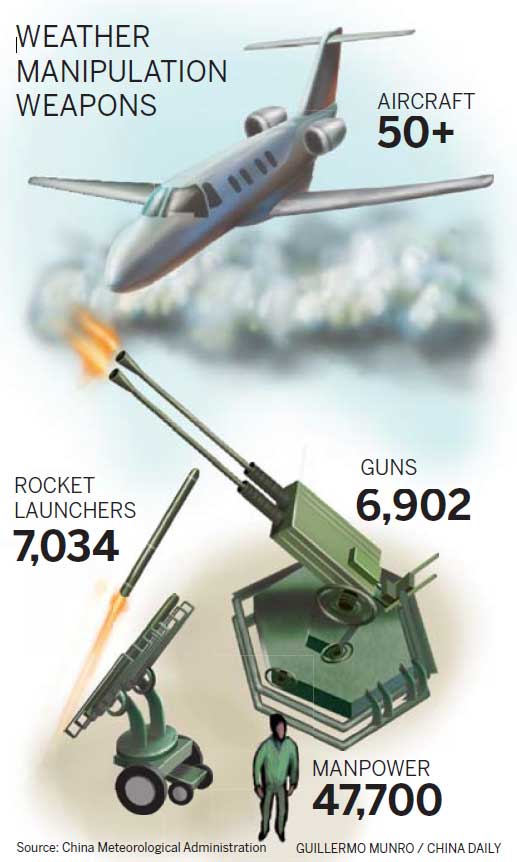Better tech to boost weather manipulation
Updated: 2012-05-23 02:51
By Zheng Xin (China Daily)
|
||||||||
Rainmaking technology will be better deployed and there will be more of it, a leading meteorologist promised.
The country plans to increase artificial precipitation by 3 to 5 percentage points in the next five years, Zheng Guoguang, administrator of the China Meteorological Administration, said.
Rainmaking technology in China lags behind the leading countries in the field by between 15 and 45 percent, depending on the region, he said. The arsenal targeting the weather includes more than 7,000 rocket launchers, at least 50 planes and nearly 7,000 guns.
Management capability will also be enhanced, Zheng said during the National Weather Modification Conference in Beijing on Tuesday.
|
|
"Many of the nation's natural and agricultural disasters, especially those involving grain and tobacco, are caused by drought," he said.
"With so many areas in China, especially rural areas, vulnerable to storms, blizzards, hail and other natural disasters, the demand has been rapidly increasing to use science and technology to reduce the risks."
Weather modification involves seeding clouds with grains of dry ice (solid carbon dioxide) or tiny particles of silver iodide to stimulate rainfall. Its use has been expanding nationally in recent years to tackle drought, hailstones, forest fires and floods.
Some 560,000 manipulations of the weather have been conducted since 2002 using rockets and projectiles carrying dry ice or silver iodide according to figures from the China Meteorological Administration.
That helped release 489.7 billion tons of rain, about 12 times the water storage of the Three Gorges Project and saved about 66 billion yuan ($10.4 billion) in economic losses.
Weather manipulation started in 1958, Wang Guanghe, deputy director of the artificial weather intervention center under the China Meteorological Administration, said.
Lack of investment in scientific and technological research has also slowed down development, Wang said.
The government has already launched a special 160 million yuan fund to subsidize areas prone to natural disasters, including drought and haze.
The fund will go to projects to bring about more rain, snow and prevent hail showers.
Aircraft, guns and rockets will be used to prevent unpredictable weather from disrupting major events.
It is the first time that the government subsidized regional efforts to manipulate the weather.
Enhancing information flow among regions will also improve manipulation, Wang said.
A lack of cloud-seeding equipment in some cities and an absence of a system to ensure information is relayed properly hampers efforts to concentrate on more than one particular region at a time, Wang said.
Besides, professional training and safety supervision also have an impact, he said.
There is concern over potential pollution hazards attached to the intervention projects.
However, Wang dismissed these concerns.
"Very few doses of dry ice or silver iodide are used," he said.
"The silver is heavy metal and the amount that is used is so little that it can be ignored."
zhengxin@chinadaily.com.cn

 Relief reaches isolated village
Relief reaches isolated village
 Rainfall poses new threats to quake-hit region
Rainfall poses new threats to quake-hit region
 Funerals begin for Boston bombing victims
Funerals begin for Boston bombing victims
 Quake takeaway from China's Air Force
Quake takeaway from China's Air Force
 Obama celebrates young inventors at science fair
Obama celebrates young inventors at science fair
 Earth Day marked around the world
Earth Day marked around the world
 Volunteer team helping students find sense of normalcy
Volunteer team helping students find sense of normalcy
 Ethnic groups quick to join rescue efforts
Ethnic groups quick to join rescue efforts
Most Viewed
Editor's Picks

|

|

|

|

|

|
Today's Top News
Health new priority for quake zone
Xi meets US top military officer
Japan's boats driven out of Diaoyu
China mulls online shopping legislation
Bird flu death toll rises to 22
Putin appoints new ambassador to China
Japanese ships blocked from Diaoyu Islands
Inspired by Guan, more Chinese pick up golf
US Weekly

|

|







